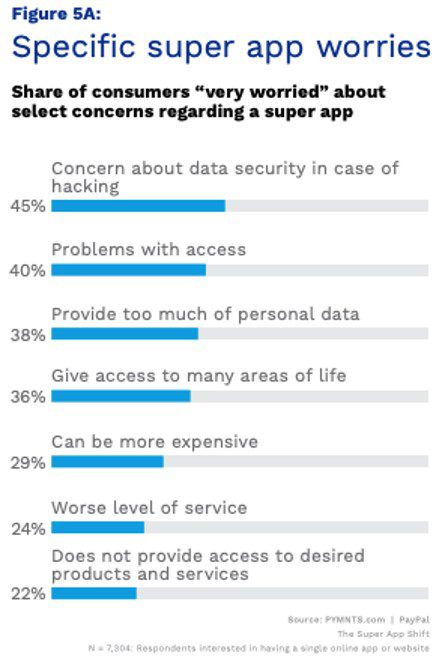A super app is an all-in-one mobile application that provides a wide range of services and functions, allowing users to perform various tasks within the app instead of using multiple separate apps.
Super apps often have a broad scope and can include features such as social networking, eCommerce, banking, transportation payments and more. They are designed to be convenient and efficient, providing users with a one-stop solution for many of their daily needs. Because of their broad service scope, these apps often have large user bases.
Such platforms are popular in Asia. Examples include WeChat in China and Gojek in Indonesia, both of which are poised to expand to other markets.
As much as is being made of the super app phenomenon in markets where they’re already in high use, like China, some still struggle with the basic idea of one app to rule them all.
According to a survey of almost 10,000 consumers in the U.S., the U.K., Australia, and Germany for PYMNTS and PayPal’s report, “Super Apps For The Super Connected,” it is estimated that 96 million people in these markets are drawn to the idea of a centralized user interface through which they can conduct their online activities.
Advertisement: Scroll to Continue

The findings also indicate that those most interested in a super app option are millennials, bridge millennials, and Generation Z consumers, the generations that grew up on smartphones and who tend to be most comfortable with app-based shopping, payments, messaging and media.
Of the three personas we identified, it’s the group termed “tech-driven” that shows the greatest interest, with the study noting that this group owns seven to eight digital devices on average and represents 12% of respondents, equating to roughly 48 million consumers. They are primarily millennials, at 42%, and high-income consumers, at 50%.
Get the study: Super Apps For The Super Connected
Super App Security Concerns
An earlier study in the PYMNTS and PayPal series, “The Super App Shift: How Consumers Want To Save, Shop And Spend In The Connected Economy,” noted that one of the few barriers to uptake is fear about data security.
“Prospective users’ concerns tend to center on data security and data management,” we wrote. “Our research finds that 45% of consumers would remain “very worried” about being hacked if they used a super app and 38% had concerns about how much data they would have to share to gain access to its features. This concern is nearly universal, and 5% more German consumers show concern than other groups.”

Read the report: The Super App Shift: How Consumers Want To Save, Shop, And Spend In The Connected Economy
As with any software application, the safety of a super app depends on a variety of factors, including the security measures implemented by the developers and the user’s own security practices. Some super apps have been criticized for their data collection and privacy policies, so it is important for users to be aware of these issues and make informed decisions about the apps they use.
To ensure the safety of your personal information, it is always a good idea to research the app before downloading it, read reviews and user comments, and pay attention to any warning messages or prompts from your device’s operating system. It is also important to use strong passwords and enable two-factor authentication whenever possible, and to be cautious when entering sensitive information such as financial or personal details.
It is difficult to predict the future of super apps with certainty, as it depends on a variety of factors such as market demand, technological advances and the actions of individual companies. However, it is likely that super apps will continue to evolve and become more sophisticated over time, incorporating new features and services as they become available.
One trend that may continue is the integration of artificial intelligence and machine learning into these platforms, which could enable them to offer more personalized and efficient services to users. It is also possible that these apps will expand their scope to include more sectors and industries, potentially becoming an even more integral part of people’s daily lives.
Ultimately, the future of super apps will be shaped by the needs and preferences of consumers, as well as the efforts of developers to create innovative and useful apps.